Advanced Encryption Standard (AES) and Data Encryption Standard (DES): A Comparative Analysis
VerifiedAdded on 2024/06/04
|18
|4565
|208
AI Summary
This paper provides a comprehensive analysis of the Advanced Encryption Standard (AES) and the Data Encryption Standard (DES), two widely used symmetric block ciphers. It delves into the historical context, design principles, strengths, weaknesses, and practical applications of both algorithms. The paper highlights the key differences between AES and DES, emphasizing the reasons why AES has become the preferred choice for modern cryptographic applications. It also explores the future directions of cryptography, considering the evolving landscape of cyber threats and the need for robust security solutions.
Contribute Materials
Your contribution can guide someone’s learning journey. Share your
documents today.
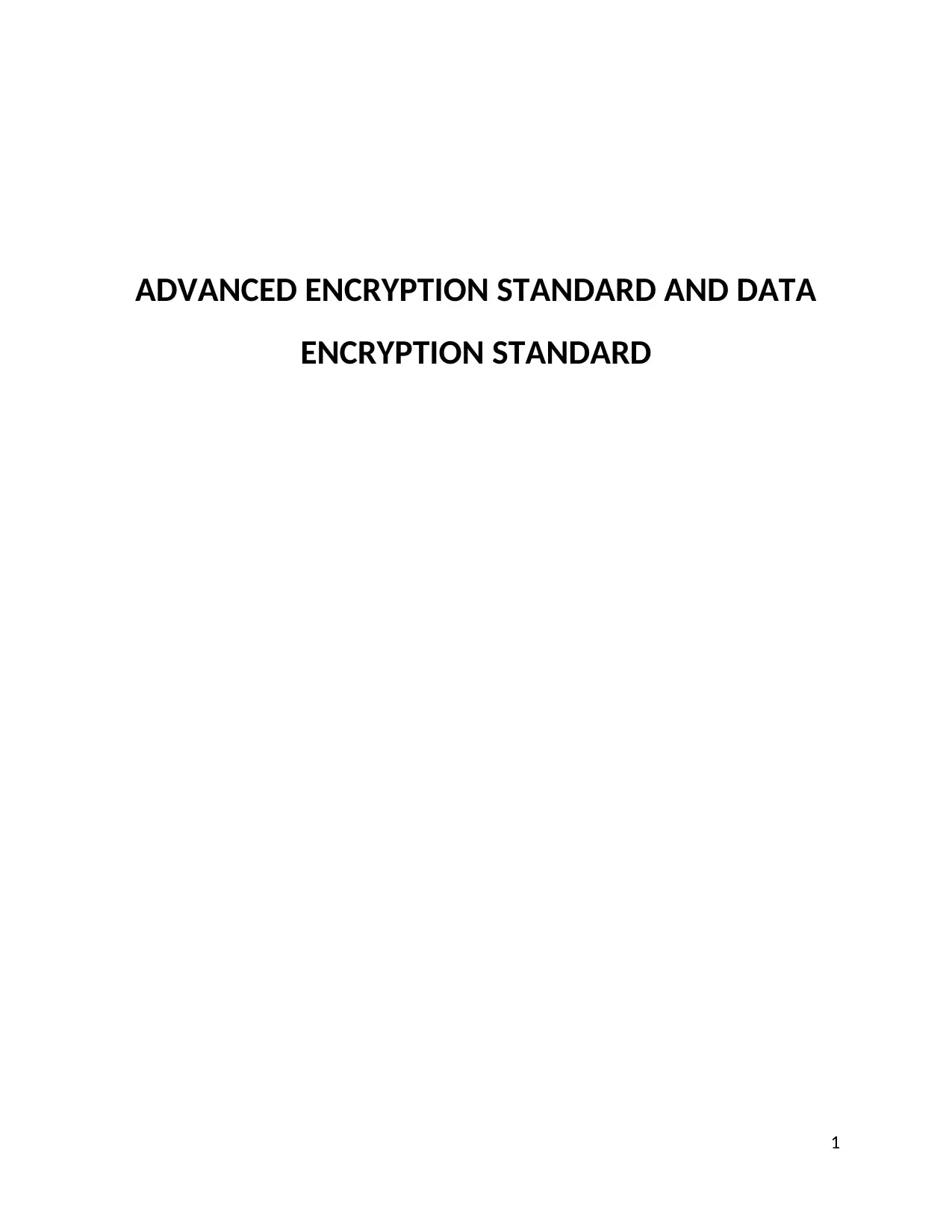
ADVANCED ENCRYPTION STANDARD AND DATA
ENCRYPTION STANDARD
1
ENCRYPTION STANDARD
1
Secure Best Marks with AI Grader
Need help grading? Try our AI Grader for instant feedback on your assignments.
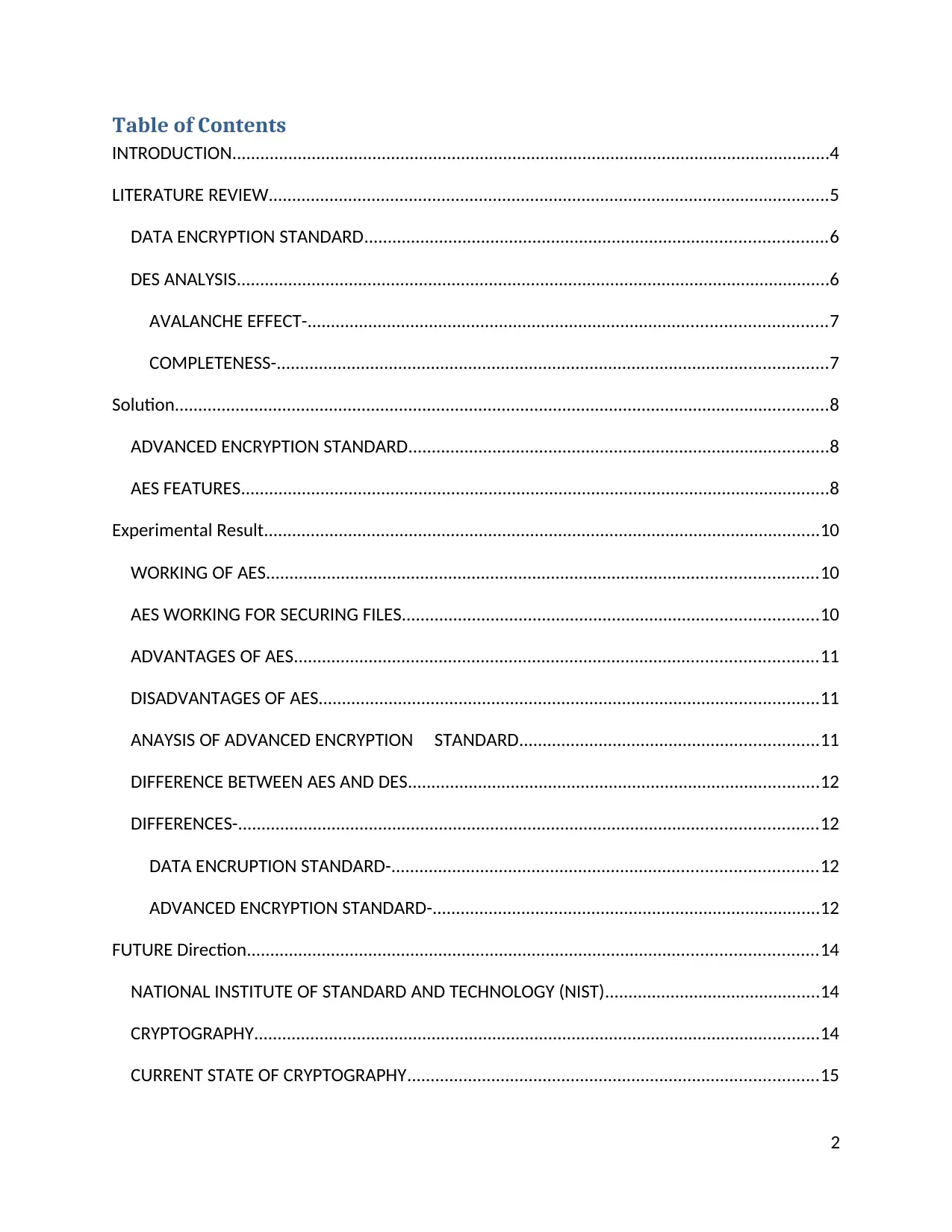
Table of Contents
INTRODUCTION................................................................................................................................4
LITERATURE REVIEW........................................................................................................................5
DATA ENCRYPTION STANDARD...................................................................................................6
DES ANALYSIS...............................................................................................................................6
AVALANCHE EFFECT-...............................................................................................................7
COMPLETENESS-......................................................................................................................7
Solution............................................................................................................................................8
ADVANCED ENCRYPTION STANDARD..........................................................................................8
AES FEATURES..............................................................................................................................8
Experimental Result.......................................................................................................................10
WORKING OF AES......................................................................................................................10
AES WORKING FOR SECURING FILES.........................................................................................10
ADVANTAGES OF AES................................................................................................................11
DISADVANTAGES OF AES...........................................................................................................11
ANAYSIS OF ADVANCED ENCRYPTION STANDARD................................................................11
DIFFERENCE BETWEEN AES AND DES........................................................................................12
DIFFERENCES-............................................................................................................................12
DATA ENCRUPTION STANDARD-...........................................................................................12
ADVANCED ENCRYPTION STANDARD-...................................................................................12
FUTURE Direction..........................................................................................................................14
NATIONAL INSTITUTE OF STANDARD AND TECHNOLOGY (NIST)..............................................14
CRYPTOGRAPHY.........................................................................................................................14
CURRENT STATE OF CRYPTOGRAPHY........................................................................................15
2
INTRODUCTION................................................................................................................................4
LITERATURE REVIEW........................................................................................................................5
DATA ENCRYPTION STANDARD...................................................................................................6
DES ANALYSIS...............................................................................................................................6
AVALANCHE EFFECT-...............................................................................................................7
COMPLETENESS-......................................................................................................................7
Solution............................................................................................................................................8
ADVANCED ENCRYPTION STANDARD..........................................................................................8
AES FEATURES..............................................................................................................................8
Experimental Result.......................................................................................................................10
WORKING OF AES......................................................................................................................10
AES WORKING FOR SECURING FILES.........................................................................................10
ADVANTAGES OF AES................................................................................................................11
DISADVANTAGES OF AES...........................................................................................................11
ANAYSIS OF ADVANCED ENCRYPTION STANDARD................................................................11
DIFFERENCE BETWEEN AES AND DES........................................................................................12
DIFFERENCES-............................................................................................................................12
DATA ENCRUPTION STANDARD-...........................................................................................12
ADVANCED ENCRYPTION STANDARD-...................................................................................12
FUTURE Direction..........................................................................................................................14
NATIONAL INSTITUTE OF STANDARD AND TECHNOLOGY (NIST)..............................................14
CRYPTOGRAPHY.........................................................................................................................14
CURRENT STATE OF CRYPTOGRAPHY........................................................................................15
2

CONCLUSION.............................................................................................................................16
REFERENCE.....................................................................................................................................17
3
REFERENCE.....................................................................................................................................17
3
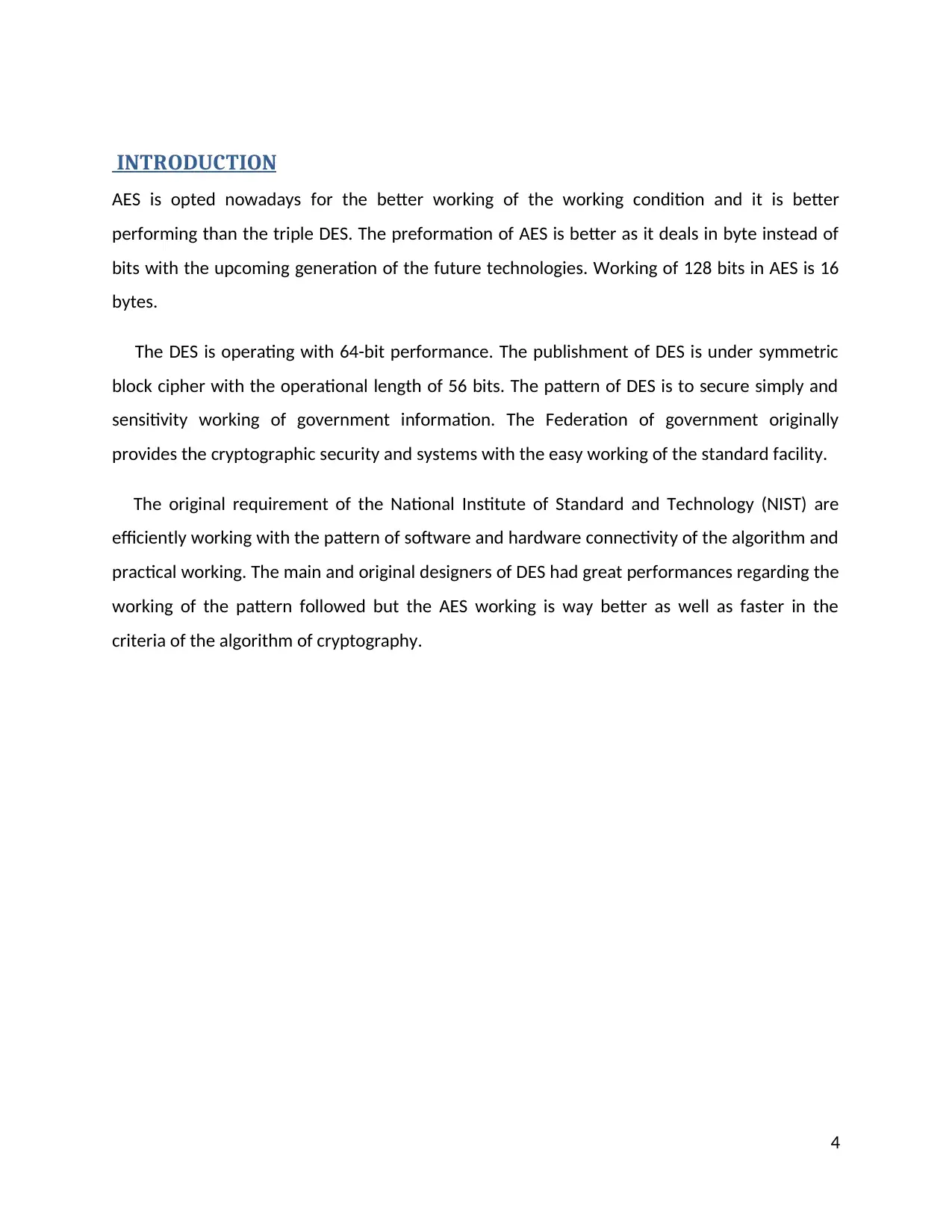
INTRODUCTION
AES is opted nowadays for the better working of the working condition and it is better
performing than the triple DES. The preformation of AES is better as it deals in byte instead of
bits with the upcoming generation of the future technologies. Working of 128 bits in AES is 16
bytes.
The DES is operating with 64-bit performance. The publishment of DES is under symmetric
block cipher with the operational length of 56 bits. The pattern of DES is to secure simply and
sensitivity working of government information. The Federation of government originally
provides the cryptographic security and systems with the easy working of the standard facility.
The original requirement of the National Institute of Standard and Technology (NIST) are
efficiently working with the pattern of software and hardware connectivity of the algorithm and
practical working. The main and original designers of DES had great performances regarding the
working of the pattern followed but the AES working is way better as well as faster in the
criteria of the algorithm of cryptography.
4
AES is opted nowadays for the better working of the working condition and it is better
performing than the triple DES. The preformation of AES is better as it deals in byte instead of
bits with the upcoming generation of the future technologies. Working of 128 bits in AES is 16
bytes.
The DES is operating with 64-bit performance. The publishment of DES is under symmetric
block cipher with the operational length of 56 bits. The pattern of DES is to secure simply and
sensitivity working of government information. The Federation of government originally
provides the cryptographic security and systems with the easy working of the standard facility.
The original requirement of the National Institute of Standard and Technology (NIST) are
efficiently working with the pattern of software and hardware connectivity of the algorithm and
practical working. The main and original designers of DES had great performances regarding the
working of the pattern followed but the AES working is way better as well as faster in the
criteria of the algorithm of cryptography.
4
Secure Best Marks with AI Grader
Need help grading? Try our AI Grader for instant feedback on your assignments.
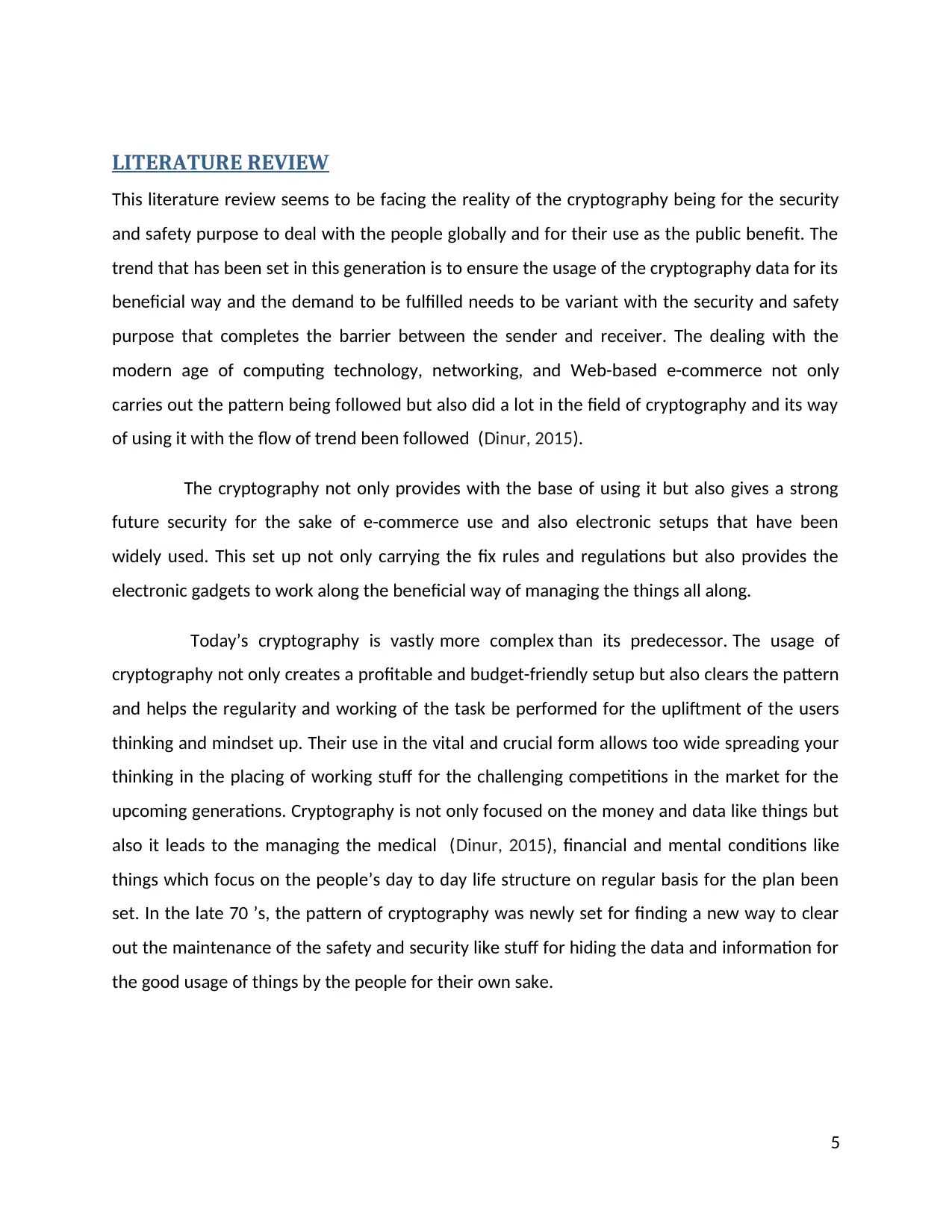
LITERATURE REVIEW
This literature review seems to be facing the reality of the cryptography being for the security
and safety purpose to deal with the people globally and for their use as the public benefit. The
trend that has been set in this generation is to ensure the usage of the cryptography data for its
beneficial way and the demand to be fulfilled needs to be variant with the security and safety
purpose that completes the barrier between the sender and receiver. The dealing with the
modern age of computing technology, networking, and Web-based e-commerce not only
carries out the pattern being followed but also did a lot in the field of cryptography and its way
of using it with the flow of trend been followed (Dinur, 2015).
The cryptography not only provides with the base of using it but also gives a strong
future security for the sake of e-commerce use and also electronic setups that have been
widely used. This set up not only carrying the fix rules and regulations but also provides the
electronic gadgets to work along the beneficial way of managing the things all along.
Today’s cryptography is vastly more complex than its predecessor. The usage of
cryptography not only creates a profitable and budget-friendly setup but also clears the pattern
and helps the regularity and working of the task be performed for the upliftment of the users
thinking and mindset up. Their use in the vital and crucial form allows too wide spreading your
thinking in the placing of working stuff for the challenging competitions in the market for the
upcoming generations. Cryptography is not only focused on the money and data like things but
also it leads to the managing the medical (Dinur, 2015), financial and mental conditions like
things which focus on the people’s day to day life structure on regular basis for the plan been
set. In the late 70 ’s, the pattern of cryptography was newly set for finding a new way to clear
out the maintenance of the safety and security like stuff for hiding the data and information for
the good usage of things by the people for their own sake.
5
This literature review seems to be facing the reality of the cryptography being for the security
and safety purpose to deal with the people globally and for their use as the public benefit. The
trend that has been set in this generation is to ensure the usage of the cryptography data for its
beneficial way and the demand to be fulfilled needs to be variant with the security and safety
purpose that completes the barrier between the sender and receiver. The dealing with the
modern age of computing technology, networking, and Web-based e-commerce not only
carries out the pattern being followed but also did a lot in the field of cryptography and its way
of using it with the flow of trend been followed (Dinur, 2015).
The cryptography not only provides with the base of using it but also gives a strong
future security for the sake of e-commerce use and also electronic setups that have been
widely used. This set up not only carrying the fix rules and regulations but also provides the
electronic gadgets to work along the beneficial way of managing the things all along.
Today’s cryptography is vastly more complex than its predecessor. The usage of
cryptography not only creates a profitable and budget-friendly setup but also clears the pattern
and helps the regularity and working of the task be performed for the upliftment of the users
thinking and mindset up. Their use in the vital and crucial form allows too wide spreading your
thinking in the placing of working stuff for the challenging competitions in the market for the
upcoming generations. Cryptography is not only focused on the money and data like things but
also it leads to the managing the medical (Dinur, 2015), financial and mental conditions like
things which focus on the people’s day to day life structure on regular basis for the plan been
set. In the late 70 ’s, the pattern of cryptography was newly set for finding a new way to clear
out the maintenance of the safety and security like stuff for hiding the data and information for
the good usage of things by the people for their own sake.
5
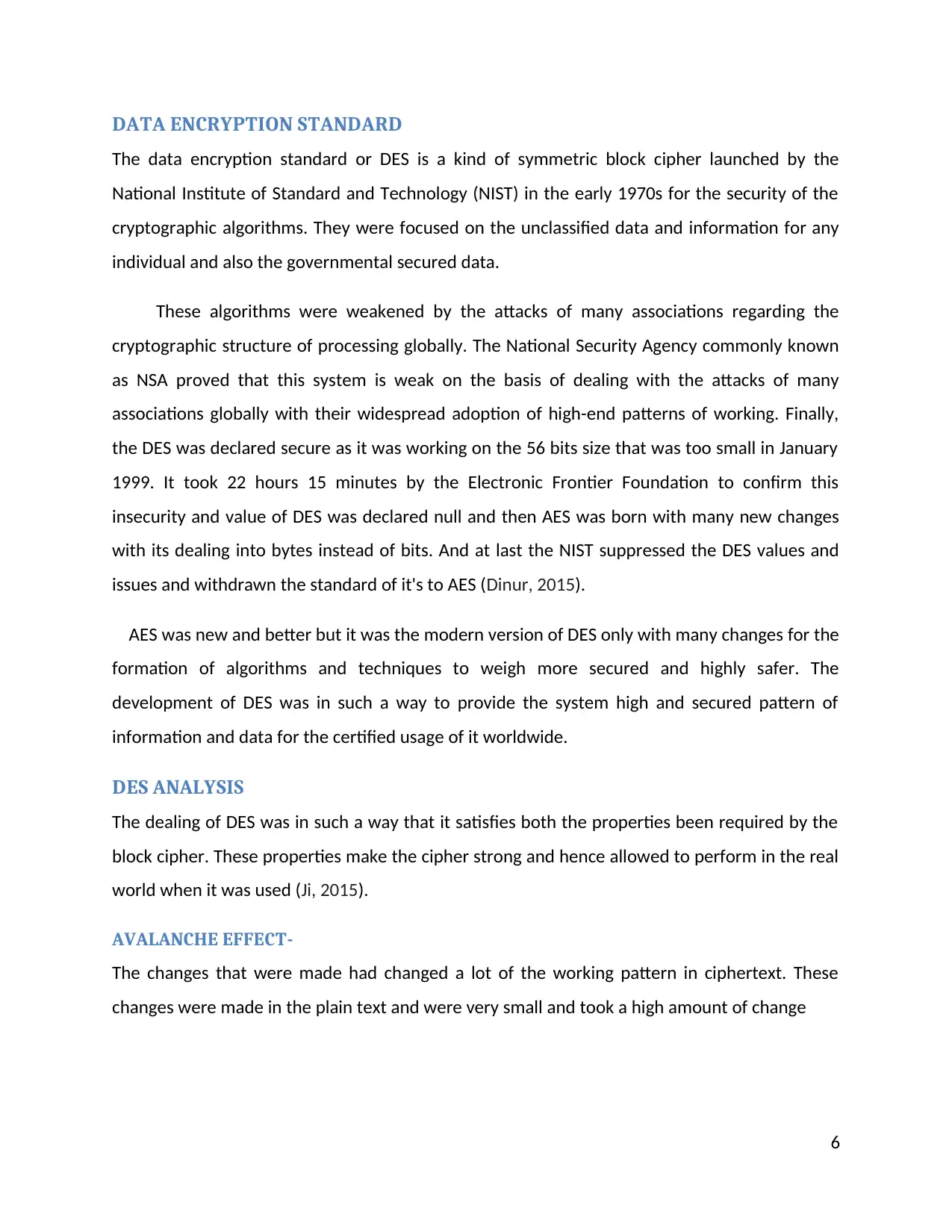
DATA ENCRYPTION STANDARD
The data encryption standard or DES is a kind of symmetric block cipher launched by the
National Institute of Standard and Technology (NIST) in the early 1970s for the security of the
cryptographic algorithms. They were focused on the unclassified data and information for any
individual and also the governmental secured data.
These algorithms were weakened by the attacks of many associations regarding the
cryptographic structure of processing globally. The National Security Agency commonly known
as NSA proved that this system is weak on the basis of dealing with the attacks of many
associations globally with their widespread adoption of high-end patterns of working. Finally,
the DES was declared secure as it was working on the 56 bits size that was too small in January
1999. It took 22 hours 15 minutes by the Electronic Frontier Foundation to confirm this
insecurity and value of DES was declared null and then AES was born with many new changes
with its dealing into bytes instead of bits. And at last the NIST suppressed the DES values and
issues and withdrawn the standard of it's to AES (Dinur, 2015).
AES was new and better but it was the modern version of DES only with many changes for the
formation of algorithms and techniques to weigh more secured and highly safer. The
development of DES was in such a way to provide the system high and secured pattern of
information and data for the certified usage of it worldwide.
DES ANALYSIS
The dealing of DES was in such a way that it satisfies both the properties been required by the
block cipher. These properties make the cipher strong and hence allowed to perform in the real
world when it was used (Ji, 2015).
AVALANCHE EFFECT-
The changes that were made had changed a lot of the working pattern in ciphertext. These
changes were made in the plain text and were very small and took a high amount of change
6
The data encryption standard or DES is a kind of symmetric block cipher launched by the
National Institute of Standard and Technology (NIST) in the early 1970s for the security of the
cryptographic algorithms. They were focused on the unclassified data and information for any
individual and also the governmental secured data.
These algorithms were weakened by the attacks of many associations regarding the
cryptographic structure of processing globally. The National Security Agency commonly known
as NSA proved that this system is weak on the basis of dealing with the attacks of many
associations globally with their widespread adoption of high-end patterns of working. Finally,
the DES was declared secure as it was working on the 56 bits size that was too small in January
1999. It took 22 hours 15 minutes by the Electronic Frontier Foundation to confirm this
insecurity and value of DES was declared null and then AES was born with many new changes
with its dealing into bytes instead of bits. And at last the NIST suppressed the DES values and
issues and withdrawn the standard of it's to AES (Dinur, 2015).
AES was new and better but it was the modern version of DES only with many changes for the
formation of algorithms and techniques to weigh more secured and highly safer. The
development of DES was in such a way to provide the system high and secured pattern of
information and data for the certified usage of it worldwide.
DES ANALYSIS
The dealing of DES was in such a way that it satisfies both the properties been required by the
block cipher. These properties make the cipher strong and hence allowed to perform in the real
world when it was used (Ji, 2015).
AVALANCHE EFFECT-
The changes that were made had changed a lot of the working pattern in ciphertext. These
changes were made in the plain text and were very small and took a high amount of change
6

COMPLETENESS-
All the bits in which the working was done in the ciphertext were totally dependent on the bits
of plain text. The plain text was the basic version and the ciphertext was at last too dependent
on the plain text (Rihan, 2015).
7
All the bits in which the working was done in the ciphertext were totally dependent on the bits
of plain text. The plain text was the basic version and the ciphertext was at last too dependent
on the plain text (Rihan, 2015).
7
Paraphrase This Document
Need a fresh take? Get an instant paraphrase of this document with our AI Paraphraser
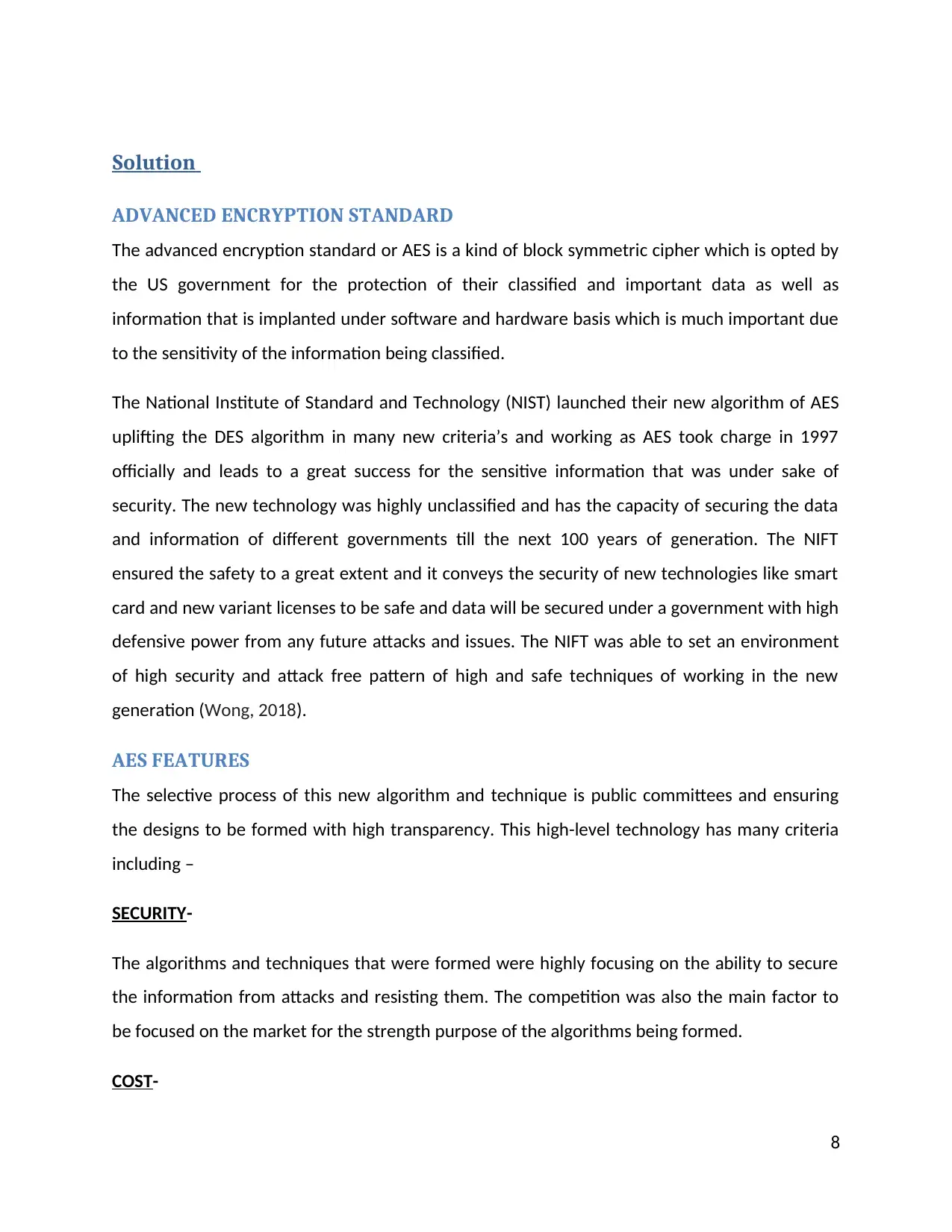
Solution
ADVANCED ENCRYPTION STANDARD
The advanced encryption standard or AES is a kind of block symmetric cipher which is opted by
the US government for the protection of their classified and important data as well as
information that is implanted under software and hardware basis which is much important due
to the sensitivity of the information being classified.
The National Institute of Standard and Technology (NIST) launched their new algorithm of AES
uplifting the DES algorithm in many new criteria’s and working as AES took charge in 1997
officially and leads to a great success for the sensitive information that was under sake of
security. The new technology was highly unclassified and has the capacity of securing the data
and information of different governments till the next 100 years of generation. The NIFT
ensured the safety to a great extent and it conveys the security of new technologies like smart
card and new variant licenses to be safe and data will be secured under a government with high
defensive power from any future attacks and issues. The NIFT was able to set an environment
of high security and attack free pattern of high and safe techniques of working in the new
generation (Wong, 2018).
AES FEATURES
The selective process of this new algorithm and technique is public committees and ensuring
the designs to be formed with high transparency. This high-level technology has many criteria
including –
SECURITY-
The algorithms and techniques that were formed were highly focusing on the ability to secure
the information from attacks and resisting them. The competition was also the main factor to
be focused on the market for the strength purpose of the algorithms being formed.
COST-
8
ADVANCED ENCRYPTION STANDARD
The advanced encryption standard or AES is a kind of block symmetric cipher which is opted by
the US government for the protection of their classified and important data as well as
information that is implanted under software and hardware basis which is much important due
to the sensitivity of the information being classified.
The National Institute of Standard and Technology (NIST) launched their new algorithm of AES
uplifting the DES algorithm in many new criteria’s and working as AES took charge in 1997
officially and leads to a great success for the sensitive information that was under sake of
security. The new technology was highly unclassified and has the capacity of securing the data
and information of different governments till the next 100 years of generation. The NIFT
ensured the safety to a great extent and it conveys the security of new technologies like smart
card and new variant licenses to be safe and data will be secured under a government with high
defensive power from any future attacks and issues. The NIFT was able to set an environment
of high security and attack free pattern of high and safe techniques of working in the new
generation (Wong, 2018).
AES FEATURES
The selective process of this new algorithm and technique is public committees and ensuring
the designs to be formed with high transparency. This high-level technology has many criteria
including –
SECURITY-
The algorithms and techniques that were formed were highly focusing on the ability to secure
the information from attacks and resisting them. The competition was also the main factor to
be focused on the market for the strength purpose of the algorithms being formed.
COST-
8
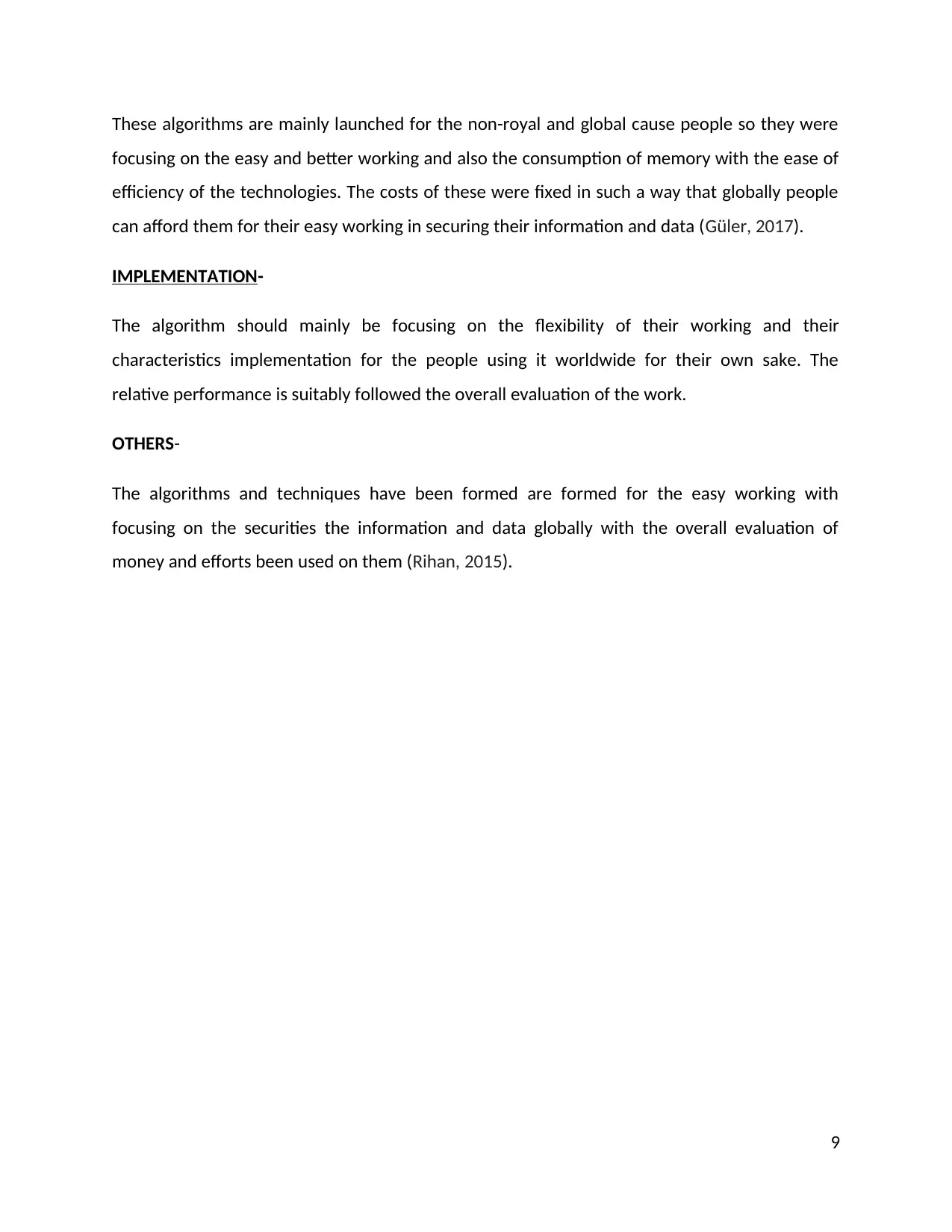
These algorithms are mainly launched for the non-royal and global cause people so they were
focusing on the easy and better working and also the consumption of memory with the ease of
efficiency of the technologies. The costs of these were fixed in such a way that globally people
can afford them for their easy working in securing their information and data (Güler, 2017).
IMPLEMENTATION-
The algorithm should mainly be focusing on the flexibility of their working and their
characteristics implementation for the people using it worldwide for their own sake. The
relative performance is suitably followed the overall evaluation of the work.
OTHERS-
The algorithms and techniques have been formed are formed for the easy working with
focusing on the securities the information and data globally with the overall evaluation of
money and efforts been used on them (Rihan, 2015).
9
focusing on the easy and better working and also the consumption of memory with the ease of
efficiency of the technologies. The costs of these were fixed in such a way that globally people
can afford them for their easy working in securing their information and data (Güler, 2017).
IMPLEMENTATION-
The algorithm should mainly be focusing on the flexibility of their working and their
characteristics implementation for the people using it worldwide for their own sake. The
relative performance is suitably followed the overall evaluation of the work.
OTHERS-
The algorithms and techniques have been formed are formed for the easy working with
focusing on the securities the information and data globally with the overall evaluation of
money and efforts been used on them (Rihan, 2015).
9
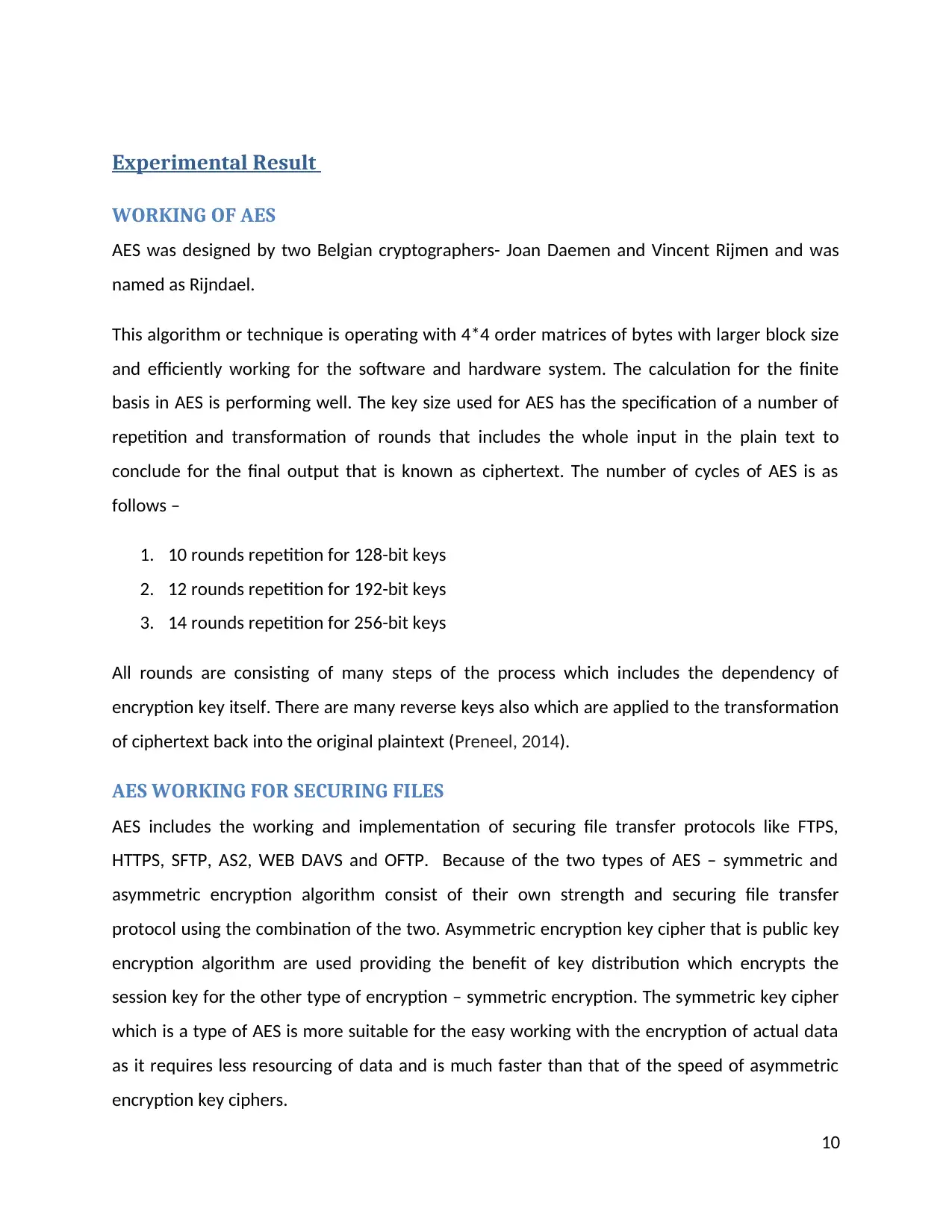
Experimental Result
WORKING OF AES
AES was designed by two Belgian cryptographers- Joan Daemen and Vincent Rijmen and was
named as Rijndael.
This algorithm or technique is operating with 4*4 order matrices of bytes with larger block size
and efficiently working for the software and hardware system. The calculation for the finite
basis in AES is performing well. The key size used for AES has the specification of a number of
repetition and transformation of rounds that includes the whole input in the plain text to
conclude for the final output that is known as ciphertext. The number of cycles of AES is as
follows –
1. 10 rounds repetition for 128-bit keys
2. 12 rounds repetition for 192-bit keys
3. 14 rounds repetition for 256-bit keys
All rounds are consisting of many steps of the process which includes the dependency of
encryption key itself. There are many reverse keys also which are applied to the transformation
of ciphertext back into the original plaintext (Preneel, 2014).
AES WORKING FOR SECURING FILES
AES includes the working and implementation of securing file transfer protocols like FTPS,
HTTPS, SFTP, AS2, WEB DAVS and OFTP. Because of the two types of AES – symmetric and
asymmetric encryption algorithm consist of their own strength and securing file transfer
protocol using the combination of the two. Asymmetric encryption key cipher that is public key
encryption algorithm are used providing the benefit of key distribution which encrypts the
session key for the other type of encryption – symmetric encryption. The symmetric key cipher
which is a type of AES is more suitable for the easy working with the encryption of actual data
as it requires less resourcing of data and is much faster than that of the speed of asymmetric
encryption key ciphers.
10
WORKING OF AES
AES was designed by two Belgian cryptographers- Joan Daemen and Vincent Rijmen and was
named as Rijndael.
This algorithm or technique is operating with 4*4 order matrices of bytes with larger block size
and efficiently working for the software and hardware system. The calculation for the finite
basis in AES is performing well. The key size used for AES has the specification of a number of
repetition and transformation of rounds that includes the whole input in the plain text to
conclude for the final output that is known as ciphertext. The number of cycles of AES is as
follows –
1. 10 rounds repetition for 128-bit keys
2. 12 rounds repetition for 192-bit keys
3. 14 rounds repetition for 256-bit keys
All rounds are consisting of many steps of the process which includes the dependency of
encryption key itself. There are many reverse keys also which are applied to the transformation
of ciphertext back into the original plaintext (Preneel, 2014).
AES WORKING FOR SECURING FILES
AES includes the working and implementation of securing file transfer protocols like FTPS,
HTTPS, SFTP, AS2, WEB DAVS and OFTP. Because of the two types of AES – symmetric and
asymmetric encryption algorithm consist of their own strength and securing file transfer
protocol using the combination of the two. Asymmetric encryption key cipher that is public key
encryption algorithm are used providing the benefit of key distribution which encrypts the
session key for the other type of encryption – symmetric encryption. The symmetric key cipher
which is a type of AES is more suitable for the easy working with the encryption of actual data
as it requires less resourcing of data and is much faster than that of the speed of asymmetric
encryption key ciphers.
10
Secure Best Marks with AI Grader
Need help grading? Try our AI Grader for instant feedback on your assignments.
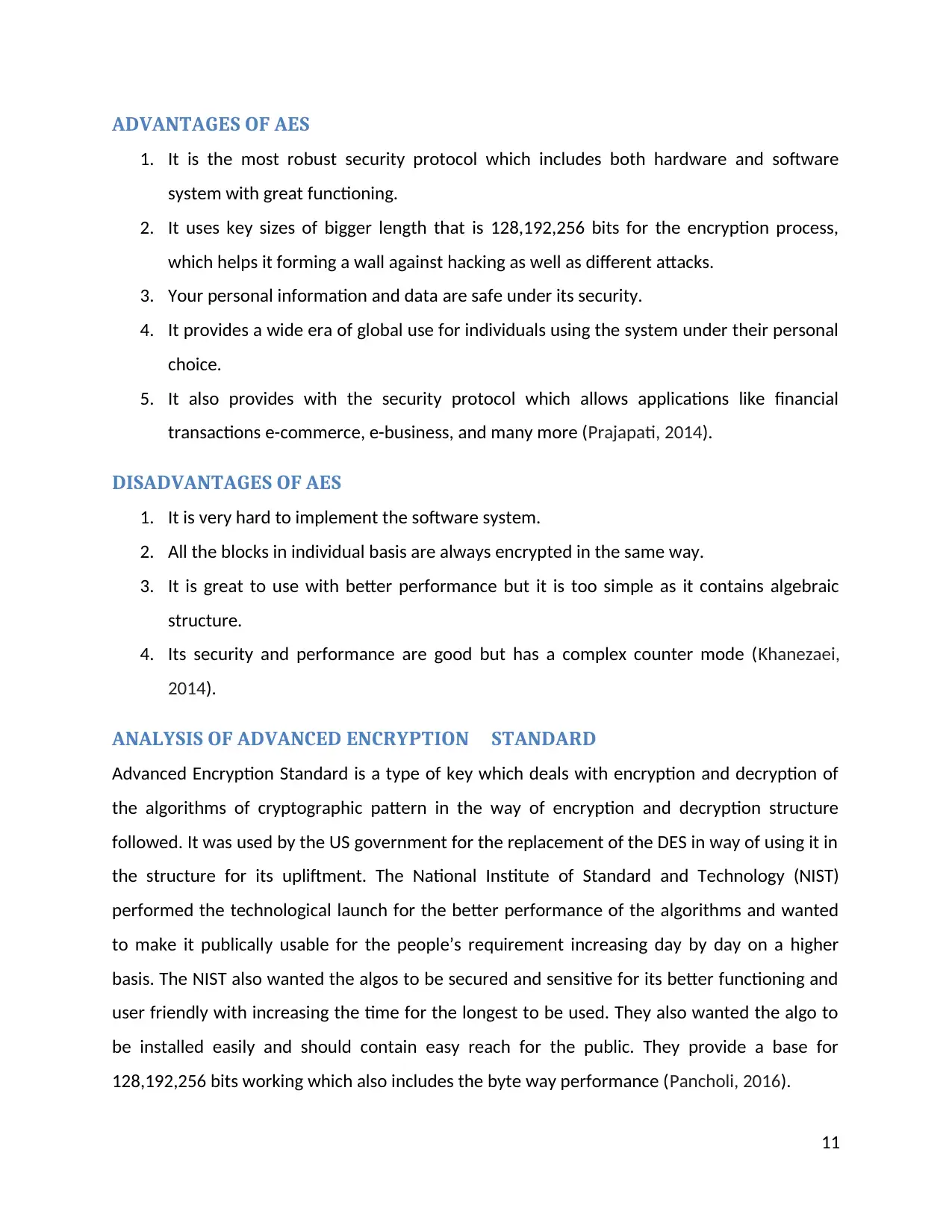
ADVANTAGES OF AES
1. It is the most robust security protocol which includes both hardware and software
system with great functioning.
2. It uses key sizes of bigger length that is 128,192,256 bits for the encryption process,
which helps it forming a wall against hacking as well as different attacks.
3. Your personal information and data are safe under its security.
4. It provides a wide era of global use for individuals using the system under their personal
choice.
5. It also provides with the security protocol which allows applications like financial
transactions e-commerce, e-business, and many more (Prajapati, 2014).
DISADVANTAGES OF AES
1. It is very hard to implement the software system.
2. All the blocks in individual basis are always encrypted in the same way.
3. It is great to use with better performance but it is too simple as it contains algebraic
structure.
4. Its security and performance are good but has a complex counter mode (Khanezaei,
2014).
ANALYSIS OF ADVANCED ENCRYPTION STANDARD
Advanced Encryption Standard is a type of key which deals with encryption and decryption of
the algorithms of cryptographic pattern in the way of encryption and decryption structure
followed. It was used by the US government for the replacement of the DES in way of using it in
the structure for its upliftment. The National Institute of Standard and Technology (NIST)
performed the technological launch for the better performance of the algorithms and wanted
to make it publically usable for the people’s requirement increasing day by day on a higher
basis. The NIST also wanted the algos to be secured and sensitive for its better functioning and
user friendly with increasing the time for the longest to be used. They also wanted the algo to
be installed easily and should contain easy reach for the public. They provide a base for
128,192,256 bits working which also includes the byte way performance (Pancholi, 2016).
11
1. It is the most robust security protocol which includes both hardware and software
system with great functioning.
2. It uses key sizes of bigger length that is 128,192,256 bits for the encryption process,
which helps it forming a wall against hacking as well as different attacks.
3. Your personal information and data are safe under its security.
4. It provides a wide era of global use for individuals using the system under their personal
choice.
5. It also provides with the security protocol which allows applications like financial
transactions e-commerce, e-business, and many more (Prajapati, 2014).
DISADVANTAGES OF AES
1. It is very hard to implement the software system.
2. All the blocks in individual basis are always encrypted in the same way.
3. It is great to use with better performance but it is too simple as it contains algebraic
structure.
4. Its security and performance are good but has a complex counter mode (Khanezaei,
2014).
ANALYSIS OF ADVANCED ENCRYPTION STANDARD
Advanced Encryption Standard is a type of key which deals with encryption and decryption of
the algorithms of cryptographic pattern in the way of encryption and decryption structure
followed. It was used by the US government for the replacement of the DES in way of using it in
the structure for its upliftment. The National Institute of Standard and Technology (NIST)
performed the technological launch for the better performance of the algorithms and wanted
to make it publically usable for the people’s requirement increasing day by day on a higher
basis. The NIST also wanted the algos to be secured and sensitive for its better functioning and
user friendly with increasing the time for the longest to be used. They also wanted the algo to
be installed easily and should contain easy reach for the public. They provide a base for
128,192,256 bits working which also includes the byte way performance (Pancholi, 2016).
11
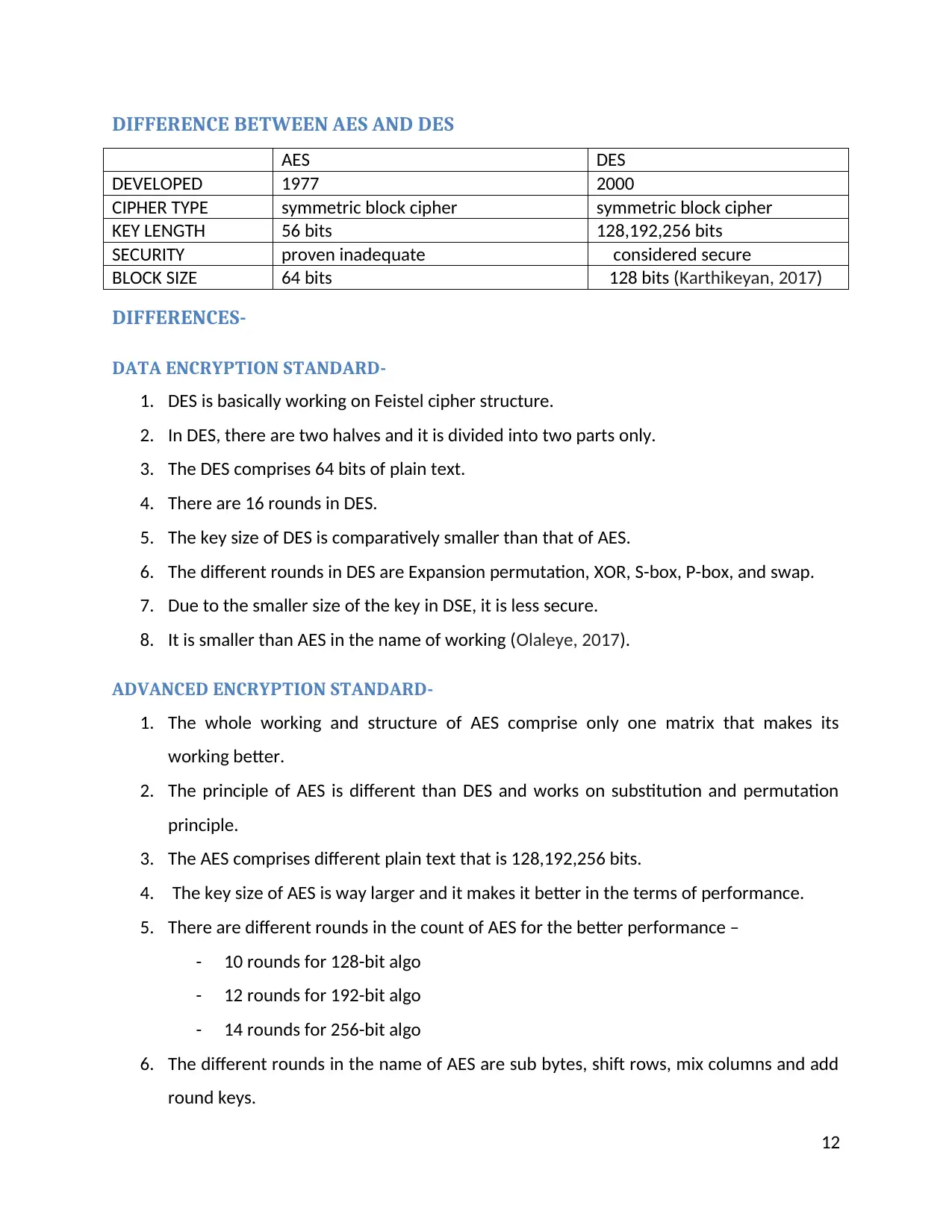
DIFFERENCE BETWEEN AES AND DES
AES DES
DEVELOPED 1977 2000
CIPHER TYPE symmetric block cipher symmetric block cipher
KEY LENGTH 56 bits 128,192,256 bits
SECURITY proven inadequate considered secure
BLOCK SIZE 64 bits 128 bits (Karthikeyan, 2017)
DIFFERENCES-
DATA ENCRYPTION STANDARD-
1. DES is basically working on Feistel cipher structure.
2. In DES, there are two halves and it is divided into two parts only.
3. The DES comprises 64 bits of plain text.
4. There are 16 rounds in DES.
5. The key size of DES is comparatively smaller than that of AES.
6. The different rounds in DES are Expansion permutation, XOR, S-box, P-box, and swap.
7. Due to the smaller size of the key in DSE, it is less secure.
8. It is smaller than AES in the name of working (Olaleye, 2017).
ADVANCED ENCRYPTION STANDARD-
1. The whole working and structure of AES comprise only one matrix that makes its
working better.
2. The principle of AES is different than DES and works on substitution and permutation
principle.
3. The AES comprises different plain text that is 128,192,256 bits.
4. The key size of AES is way larger and it makes it better in the terms of performance.
5. There are different rounds in the count of AES for the better performance –
- 10 rounds for 128-bit algo
- 12 rounds for 192-bit algo
- 14 rounds for 256-bit algo
6. The different rounds in the name of AES are sub bytes, shift rows, mix columns and add
round keys.
12
AES DES
DEVELOPED 1977 2000
CIPHER TYPE symmetric block cipher symmetric block cipher
KEY LENGTH 56 bits 128,192,256 bits
SECURITY proven inadequate considered secure
BLOCK SIZE 64 bits 128 bits (Karthikeyan, 2017)
DIFFERENCES-
DATA ENCRYPTION STANDARD-
1. DES is basically working on Feistel cipher structure.
2. In DES, there are two halves and it is divided into two parts only.
3. The DES comprises 64 bits of plain text.
4. There are 16 rounds in DES.
5. The key size of DES is comparatively smaller than that of AES.
6. The different rounds in DES are Expansion permutation, XOR, S-box, P-box, and swap.
7. Due to the smaller size of the key in DSE, it is less secure.
8. It is smaller than AES in the name of working (Olaleye, 2017).
ADVANCED ENCRYPTION STANDARD-
1. The whole working and structure of AES comprise only one matrix that makes its
working better.
2. The principle of AES is different than DES and works on substitution and permutation
principle.
3. The AES comprises different plain text that is 128,192,256 bits.
4. The key size of AES is way larger and it makes it better in the terms of performance.
5. There are different rounds in the count of AES for the better performance –
- 10 rounds for 128-bit algo
- 12 rounds for 192-bit algo
- 14 rounds for 256-bit algo
6. The different rounds in the name of AES are sub bytes, shift rows, mix columns and add
round keys.
12
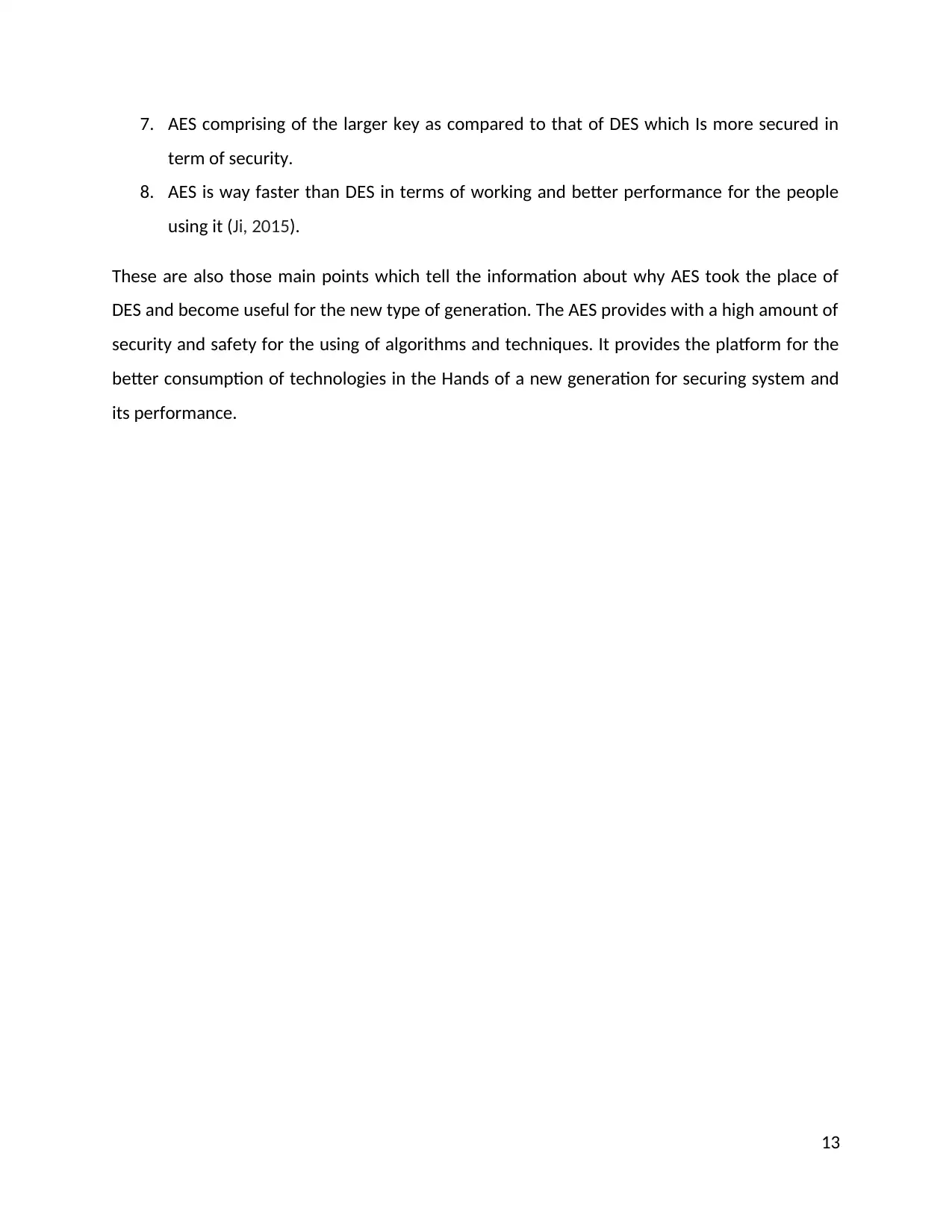
7. AES comprising of the larger key as compared to that of DES which Is more secured in
term of security.
8. AES is way faster than DES in terms of working and better performance for the people
using it (Ji, 2015).
These are also those main points which tell the information about why AES took the place of
DES and become useful for the new type of generation. The AES provides with a high amount of
security and safety for the using of algorithms and techniques. It provides the platform for the
better consumption of technologies in the Hands of a new generation for securing system and
its performance.
13
term of security.
8. AES is way faster than DES in terms of working and better performance for the people
using it (Ji, 2015).
These are also those main points which tell the information about why AES took the place of
DES and become useful for the new type of generation. The AES provides with a high amount of
security and safety for the using of algorithms and techniques. It provides the platform for the
better consumption of technologies in the Hands of a new generation for securing system and
its performance.
13
Paraphrase This Document
Need a fresh take? Get an instant paraphrase of this document with our AI Paraphraser
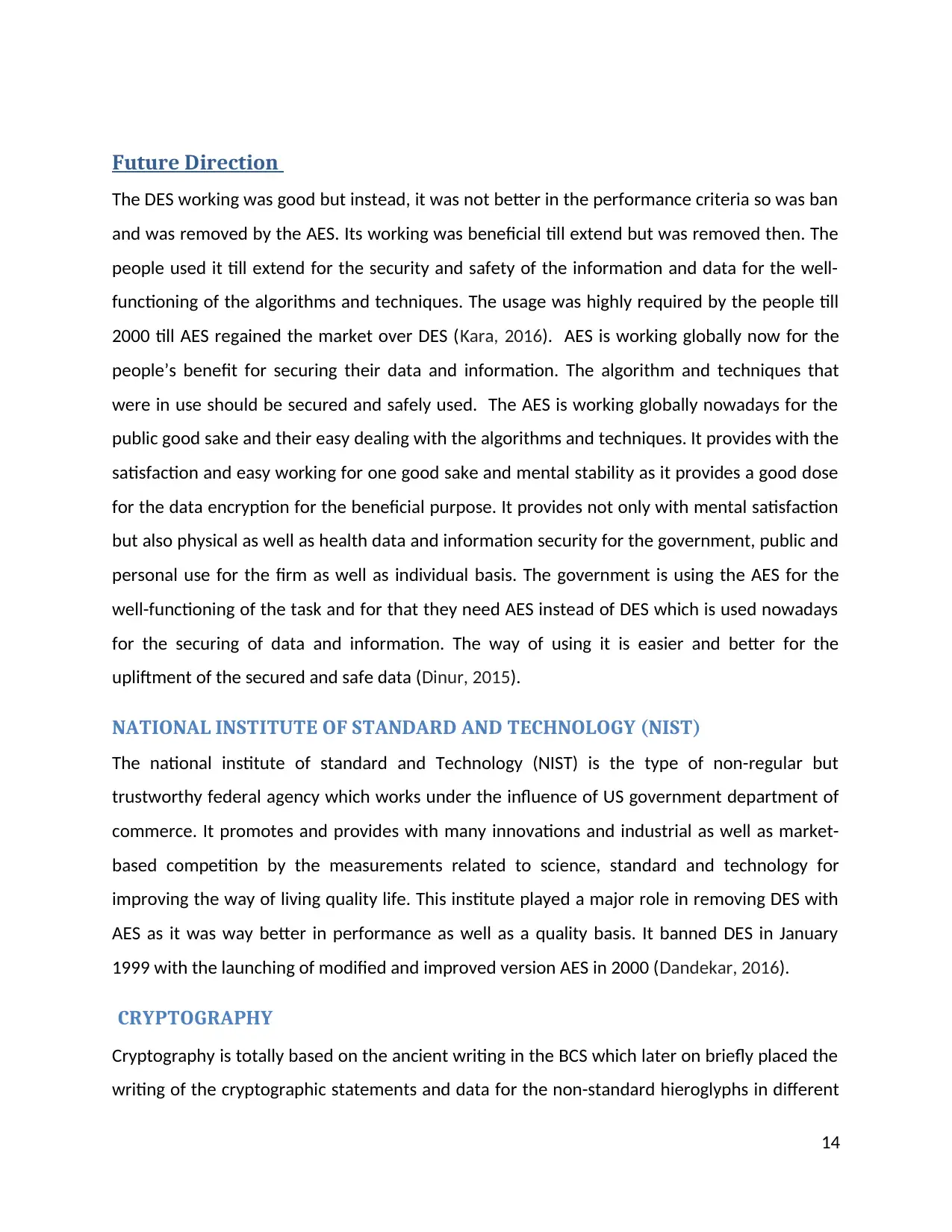
Future Direction
The DES working was good but instead, it was not better in the performance criteria so was ban
and was removed by the AES. Its working was beneficial till extend but was removed then. The
people used it till extend for the security and safety of the information and data for the well-
functioning of the algorithms and techniques. The usage was highly required by the people till
2000 till AES regained the market over DES (Kara, 2016). AES is working globally now for the
people’s benefit for securing their data and information. The algorithm and techniques that
were in use should be secured and safely used. The AES is working globally nowadays for the
public good sake and their easy dealing with the algorithms and techniques. It provides with the
satisfaction and easy working for one good sake and mental stability as it provides a good dose
for the data encryption for the beneficial purpose. It provides not only with mental satisfaction
but also physical as well as health data and information security for the government, public and
personal use for the firm as well as individual basis. The government is using the AES for the
well-functioning of the task and for that they need AES instead of DES which is used nowadays
for the securing of data and information. The way of using it is easier and better for the
upliftment of the secured and safe data (Dinur, 2015).
NATIONAL INSTITUTE OF STANDARD AND TECHNOLOGY (NIST)
The national institute of standard and Technology (NIST) is the type of non-regular but
trustworthy federal agency which works under the influence of US government department of
commerce. It promotes and provides with many innovations and industrial as well as market-
based competition by the measurements related to science, standard and technology for
improving the way of living quality life. This institute played a major role in removing DES with
AES as it was way better in performance as well as a quality basis. It banned DES in January
1999 with the launching of modified and improved version AES in 2000 (Dandekar, 2016).
CRYPTOGRAPHY
Cryptography is totally based on the ancient writing in the BCS which later on briefly placed the
writing of the cryptographic statements and data for the non-standard hieroglyphs in different
14
The DES working was good but instead, it was not better in the performance criteria so was ban
and was removed by the AES. Its working was beneficial till extend but was removed then. The
people used it till extend for the security and safety of the information and data for the well-
functioning of the algorithms and techniques. The usage was highly required by the people till
2000 till AES regained the market over DES (Kara, 2016). AES is working globally now for the
people’s benefit for securing their data and information. The algorithm and techniques that
were in use should be secured and safely used. The AES is working globally nowadays for the
public good sake and their easy dealing with the algorithms and techniques. It provides with the
satisfaction and easy working for one good sake and mental stability as it provides a good dose
for the data encryption for the beneficial purpose. It provides not only with mental satisfaction
but also physical as well as health data and information security for the government, public and
personal use for the firm as well as individual basis. The government is using the AES for the
well-functioning of the task and for that they need AES instead of DES which is used nowadays
for the securing of data and information. The way of using it is easier and better for the
upliftment of the secured and safe data (Dinur, 2015).
NATIONAL INSTITUTE OF STANDARD AND TECHNOLOGY (NIST)
The national institute of standard and Technology (NIST) is the type of non-regular but
trustworthy federal agency which works under the influence of US government department of
commerce. It promotes and provides with many innovations and industrial as well as market-
based competition by the measurements related to science, standard and technology for
improving the way of living quality life. This institute played a major role in removing DES with
AES as it was way better in performance as well as a quality basis. It banned DES in January
1999 with the launching of modified and improved version AES in 2000 (Dandekar, 2016).
CRYPTOGRAPHY
Cryptography is totally based on the ancient writing in the BCS which later on briefly placed the
writing of the cryptographic statements and data for the non-standard hieroglyphs in different
14
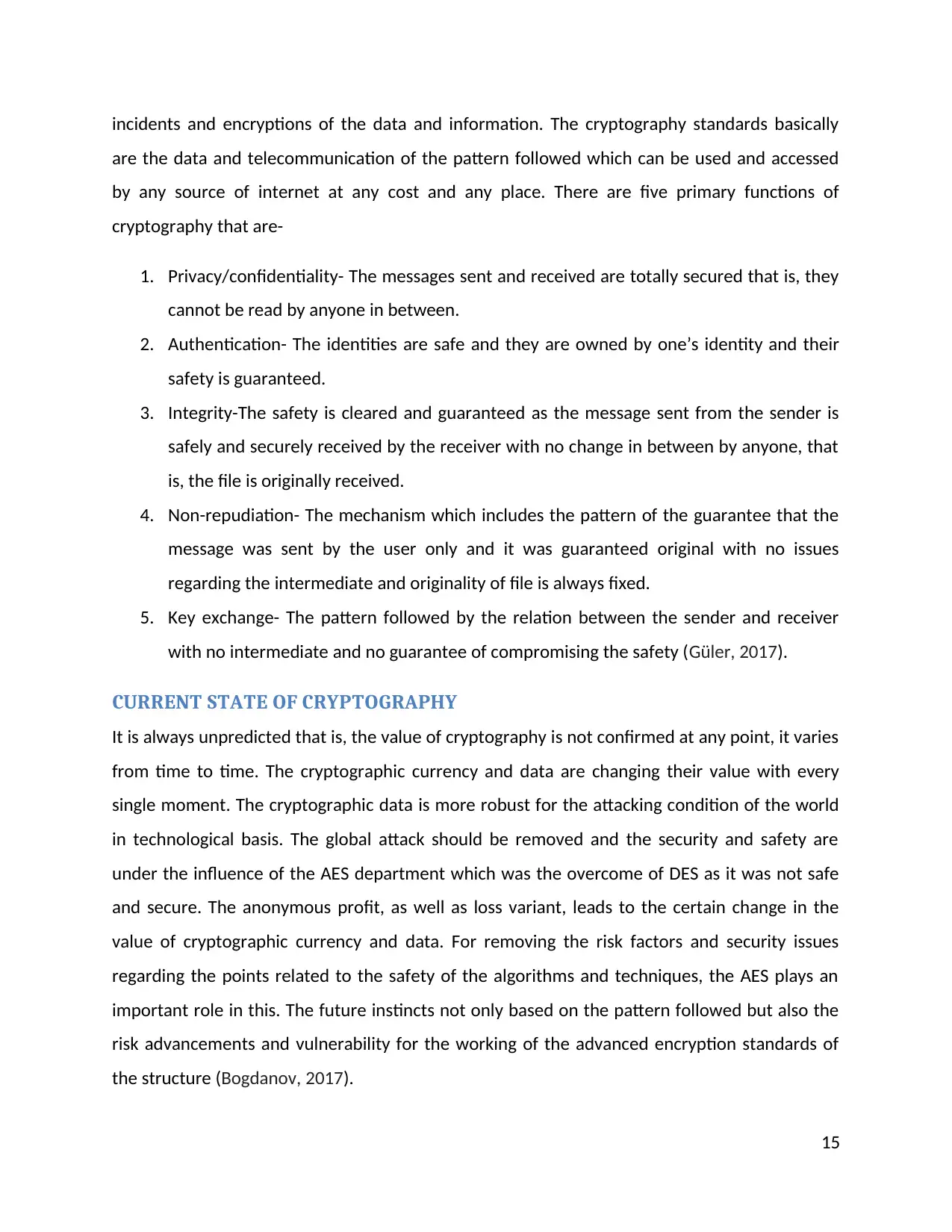
incidents and encryptions of the data and information. The cryptography standards basically
are the data and telecommunication of the pattern followed which can be used and accessed
by any source of internet at any cost and any place. There are five primary functions of
cryptography that are-
1. Privacy/confidentiality- The messages sent and received are totally secured that is, they
cannot be read by anyone in between.
2. Authentication- The identities are safe and they are owned by one’s identity and their
safety is guaranteed.
3. Integrity-The safety is cleared and guaranteed as the message sent from the sender is
safely and securely received by the receiver with no change in between by anyone, that
is, the file is originally received.
4. Non-repudiation- The mechanism which includes the pattern of the guarantee that the
message was sent by the user only and it was guaranteed original with no issues
regarding the intermediate and originality of file is always fixed.
5. Key exchange- The pattern followed by the relation between the sender and receiver
with no intermediate and no guarantee of compromising the safety (Güler, 2017).
CURRENT STATE OF CRYPTOGRAPHY
It is always unpredicted that is, the value of cryptography is not confirmed at any point, it varies
from time to time. The cryptographic currency and data are changing their value with every
single moment. The cryptographic data is more robust for the attacking condition of the world
in technological basis. The global attack should be removed and the security and safety are
under the influence of the AES department which was the overcome of DES as it was not safe
and secure. The anonymous profit, as well as loss variant, leads to the certain change in the
value of cryptographic currency and data. For removing the risk factors and security issues
regarding the points related to the safety of the algorithms and techniques, the AES plays an
important role in this. The future instincts not only based on the pattern followed but also the
risk advancements and vulnerability for the working of the advanced encryption standards of
the structure (Bogdanov, 2017).
15
are the data and telecommunication of the pattern followed which can be used and accessed
by any source of internet at any cost and any place. There are five primary functions of
cryptography that are-
1. Privacy/confidentiality- The messages sent and received are totally secured that is, they
cannot be read by anyone in between.
2. Authentication- The identities are safe and they are owned by one’s identity and their
safety is guaranteed.
3. Integrity-The safety is cleared and guaranteed as the message sent from the sender is
safely and securely received by the receiver with no change in between by anyone, that
is, the file is originally received.
4. Non-repudiation- The mechanism which includes the pattern of the guarantee that the
message was sent by the user only and it was guaranteed original with no issues
regarding the intermediate and originality of file is always fixed.
5. Key exchange- The pattern followed by the relation between the sender and receiver
with no intermediate and no guarantee of compromising the safety (Güler, 2017).
CURRENT STATE OF CRYPTOGRAPHY
It is always unpredicted that is, the value of cryptography is not confirmed at any point, it varies
from time to time. The cryptographic currency and data are changing their value with every
single moment. The cryptographic data is more robust for the attacking condition of the world
in technological basis. The global attack should be removed and the security and safety are
under the influence of the AES department which was the overcome of DES as it was not safe
and secure. The anonymous profit, as well as loss variant, leads to the certain change in the
value of cryptographic currency and data. For removing the risk factors and security issues
regarding the points related to the safety of the algorithms and techniques, the AES plays an
important role in this. The future instincts not only based on the pattern followed but also the
risk advancements and vulnerability for the working of the advanced encryption standards of
the structure (Bogdanov, 2017).
15
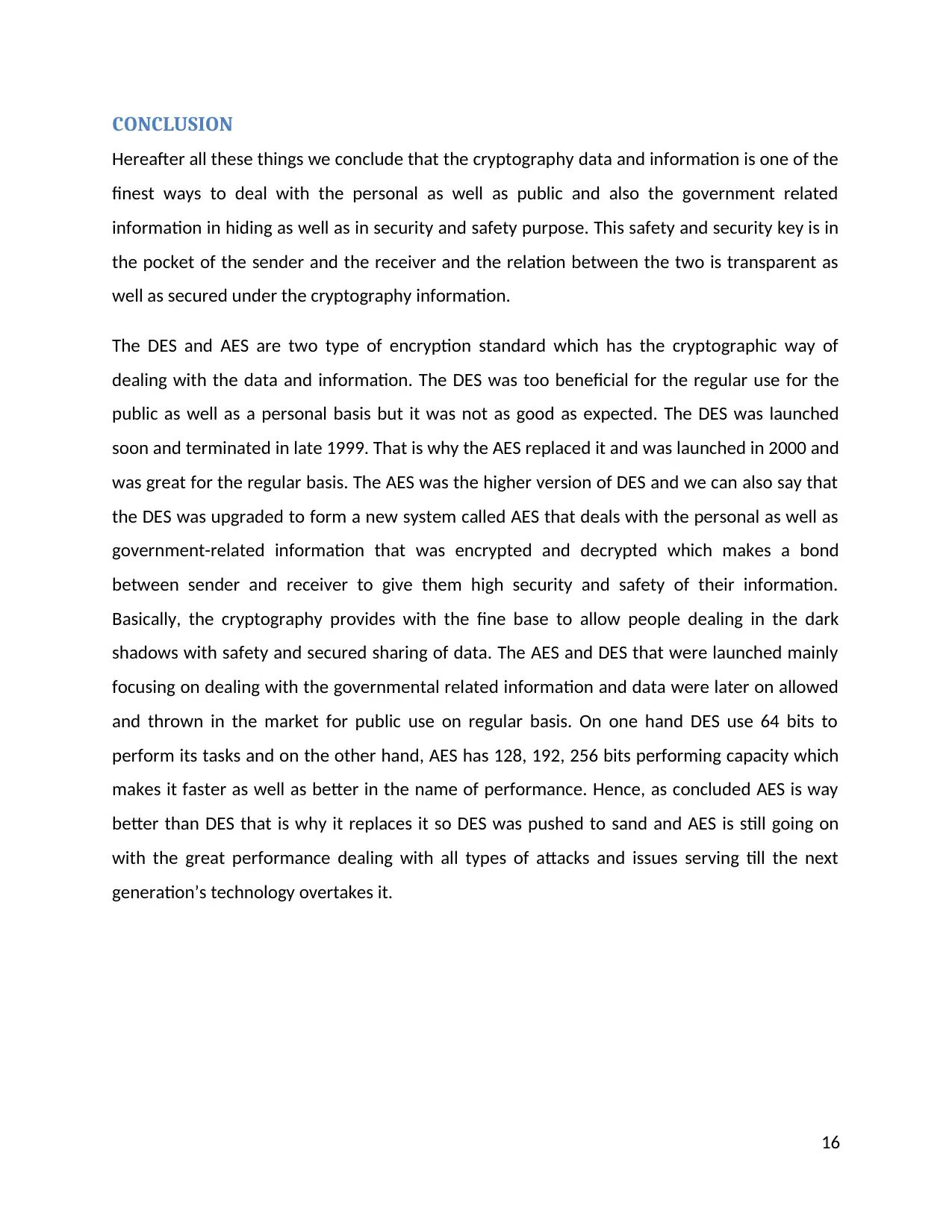
CONCLUSION
Hereafter all these things we conclude that the cryptography data and information is one of the
finest ways to deal with the personal as well as public and also the government related
information in hiding as well as in security and safety purpose. This safety and security key is in
the pocket of the sender and the receiver and the relation between the two is transparent as
well as secured under the cryptography information.
The DES and AES are two type of encryption standard which has the cryptographic way of
dealing with the data and information. The DES was too beneficial for the regular use for the
public as well as a personal basis but it was not as good as expected. The DES was launched
soon and terminated in late 1999. That is why the AES replaced it and was launched in 2000 and
was great for the regular basis. The AES was the higher version of DES and we can also say that
the DES was upgraded to form a new system called AES that deals with the personal as well as
government-related information that was encrypted and decrypted which makes a bond
between sender and receiver to give them high security and safety of their information.
Basically, the cryptography provides with the fine base to allow people dealing in the dark
shadows with safety and secured sharing of data. The AES and DES that were launched mainly
focusing on dealing with the governmental related information and data were later on allowed
and thrown in the market for public use on regular basis. On one hand DES use 64 bits to
perform its tasks and on the other hand, AES has 128, 192, 256 bits performing capacity which
makes it faster as well as better in the name of performance. Hence, as concluded AES is way
better than DES that is why it replaces it so DES was pushed to sand and AES is still going on
with the great performance dealing with all types of attacks and issues serving till the next
generation’s technology overtakes it.
16
Hereafter all these things we conclude that the cryptography data and information is one of the
finest ways to deal with the personal as well as public and also the government related
information in hiding as well as in security and safety purpose. This safety and security key is in
the pocket of the sender and the receiver and the relation between the two is transparent as
well as secured under the cryptography information.
The DES and AES are two type of encryption standard which has the cryptographic way of
dealing with the data and information. The DES was too beneficial for the regular use for the
public as well as a personal basis but it was not as good as expected. The DES was launched
soon and terminated in late 1999. That is why the AES replaced it and was launched in 2000 and
was great for the regular basis. The AES was the higher version of DES and we can also say that
the DES was upgraded to form a new system called AES that deals with the personal as well as
government-related information that was encrypted and decrypted which makes a bond
between sender and receiver to give them high security and safety of their information.
Basically, the cryptography provides with the fine base to allow people dealing in the dark
shadows with safety and secured sharing of data. The AES and DES that were launched mainly
focusing on dealing with the governmental related information and data were later on allowed
and thrown in the market for public use on regular basis. On one hand DES use 64 bits to
perform its tasks and on the other hand, AES has 128, 192, 256 bits performing capacity which
makes it faster as well as better in the name of performance. Hence, as concluded AES is way
better than DES that is why it replaces it so DES was pushed to sand and AES is still going on
with the great performance dealing with all types of attacks and issues serving till the next
generation’s technology overtakes it.
16
Secure Best Marks with AI Grader
Need help grading? Try our AI Grader for instant feedback on your assignments.
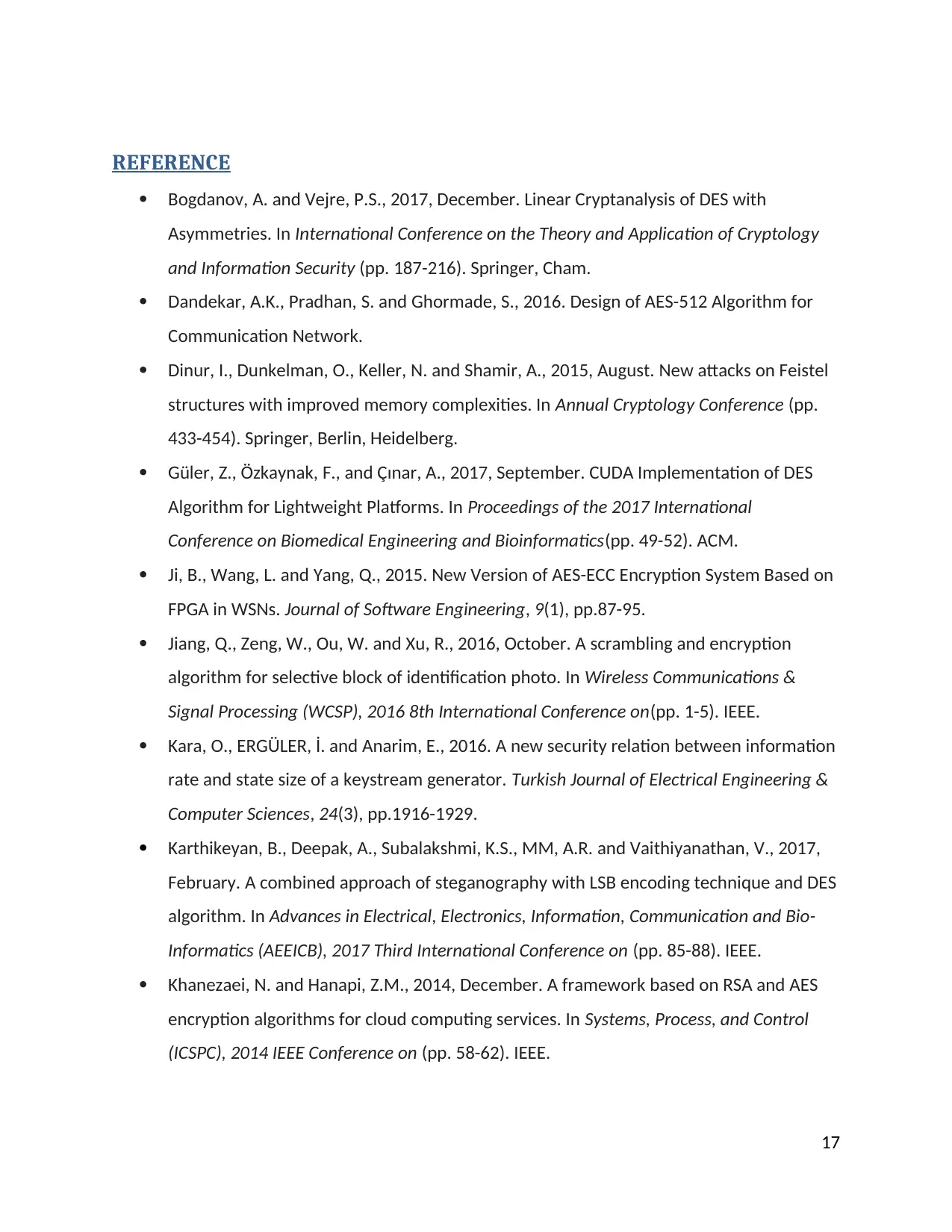
REFERENCE
Bogdanov, A. and Vejre, P.S., 2017, December. Linear Cryptanalysis of DES with
Asymmetries. In International Conference on the Theory and Application of Cryptology
and Information Security (pp. 187-216). Springer, Cham.
Dandekar, A.K., Pradhan, S. and Ghormade, S., 2016. Design of AES-512 Algorithm for
Communication Network.
Dinur, I., Dunkelman, O., Keller, N. and Shamir, A., 2015, August. New attacks on Feistel
structures with improved memory complexities. In Annual Cryptology Conference (pp.
433-454). Springer, Berlin, Heidelberg.
Güler, Z., Özkaynak, F., and Çınar, A., 2017, September. CUDA Implementation of DES
Algorithm for Lightweight Platforms. In Proceedings of the 2017 International
Conference on Biomedical Engineering and Bioinformatics(pp. 49-52). ACM.
Ji, B., Wang, L. and Yang, Q., 2015. New Version of AES-ECC Encryption System Based on
FPGA in WSNs. Journal of Software Engineering, 9(1), pp.87-95.
Jiang, Q., Zeng, W., Ou, W. and Xu, R., 2016, October. A scrambling and encryption
algorithm for selective block of identification photo. In Wireless Communications &
Signal Processing (WCSP), 2016 8th International Conference on(pp. 1-5). IEEE.
Kara, O., ERGÜLER, İ. and Anarim, E., 2016. A new security relation between information
rate and state size of a keystream generator. Turkish Journal of Electrical Engineering &
Computer Sciences, 24(3), pp.1916-1929.
Karthikeyan, B., Deepak, A., Subalakshmi, K.S., MM, A.R. and Vaithiyanathan, V., 2017,
February. A combined approach of steganography with LSB encoding technique and DES
algorithm. In Advances in Electrical, Electronics, Information, Communication and Bio-
Informatics (AEEICB), 2017 Third International Conference on (pp. 85-88). IEEE.
Khanezaei, N. and Hanapi, Z.M., 2014, December. A framework based on RSA and AES
encryption algorithms for cloud computing services. In Systems, Process, and Control
(ICSPC), 2014 IEEE Conference on (pp. 58-62). IEEE.
17
Bogdanov, A. and Vejre, P.S., 2017, December. Linear Cryptanalysis of DES with
Asymmetries. In International Conference on the Theory and Application of Cryptology
and Information Security (pp. 187-216). Springer, Cham.
Dandekar, A.K., Pradhan, S. and Ghormade, S., 2016. Design of AES-512 Algorithm for
Communication Network.
Dinur, I., Dunkelman, O., Keller, N. and Shamir, A., 2015, August. New attacks on Feistel
structures with improved memory complexities. In Annual Cryptology Conference (pp.
433-454). Springer, Berlin, Heidelberg.
Güler, Z., Özkaynak, F., and Çınar, A., 2017, September. CUDA Implementation of DES
Algorithm for Lightweight Platforms. In Proceedings of the 2017 International
Conference on Biomedical Engineering and Bioinformatics(pp. 49-52). ACM.
Ji, B., Wang, L. and Yang, Q., 2015. New Version of AES-ECC Encryption System Based on
FPGA in WSNs. Journal of Software Engineering, 9(1), pp.87-95.
Jiang, Q., Zeng, W., Ou, W. and Xu, R., 2016, October. A scrambling and encryption
algorithm for selective block of identification photo. In Wireless Communications &
Signal Processing (WCSP), 2016 8th International Conference on(pp. 1-5). IEEE.
Kara, O., ERGÜLER, İ. and Anarim, E., 2016. A new security relation between information
rate and state size of a keystream generator. Turkish Journal of Electrical Engineering &
Computer Sciences, 24(3), pp.1916-1929.
Karthikeyan, B., Deepak, A., Subalakshmi, K.S., MM, A.R. and Vaithiyanathan, V., 2017,
February. A combined approach of steganography with LSB encoding technique and DES
algorithm. In Advances in Electrical, Electronics, Information, Communication and Bio-
Informatics (AEEICB), 2017 Third International Conference on (pp. 85-88). IEEE.
Khanezaei, N. and Hanapi, Z.M., 2014, December. A framework based on RSA and AES
encryption algorithms for cloud computing services. In Systems, Process, and Control
(ICSPC), 2014 IEEE Conference on (pp. 58-62). IEEE.
17
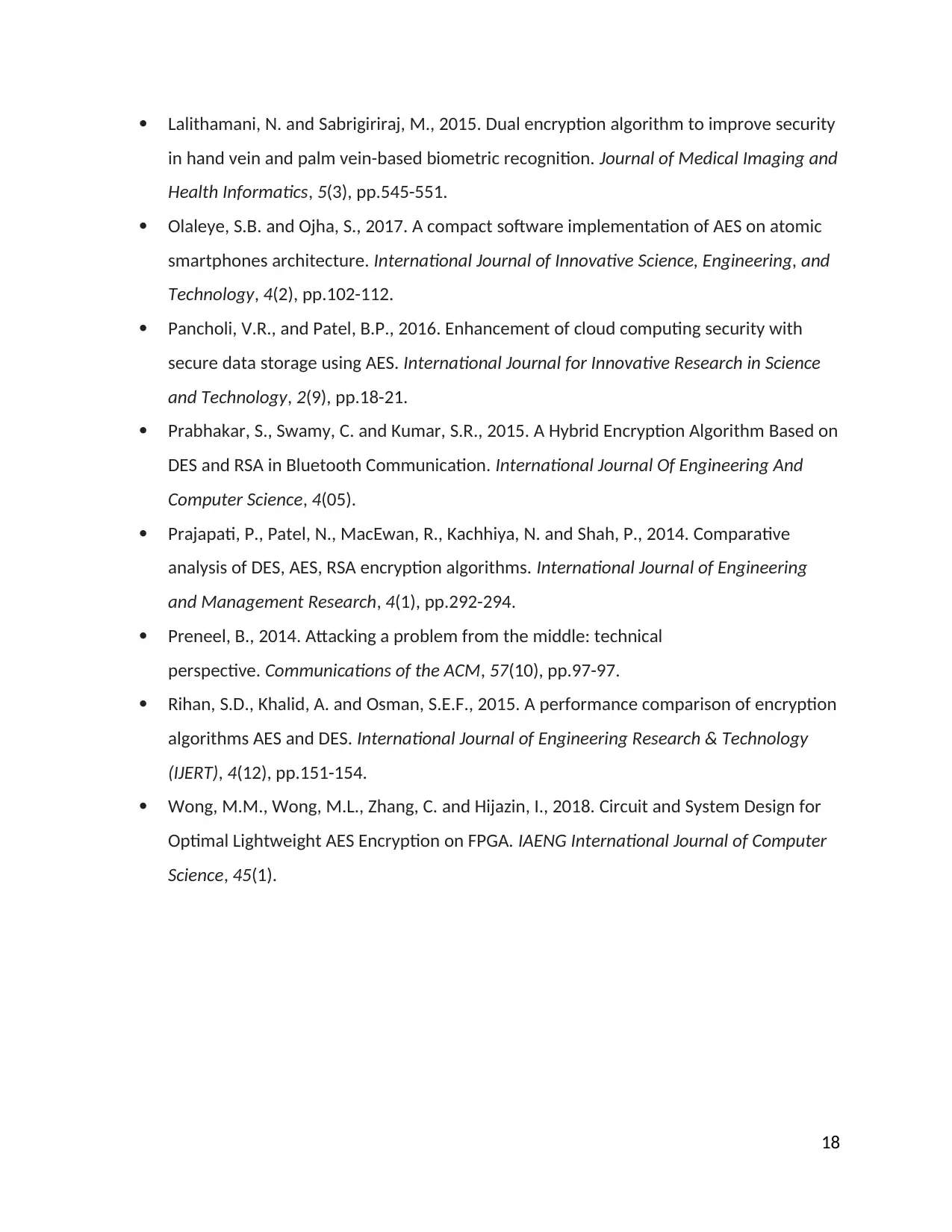
Lalithamani, N. and Sabrigiriraj, M., 2015. Dual encryption algorithm to improve security
in hand vein and palm vein-based biometric recognition. Journal of Medical Imaging and
Health Informatics, 5(3), pp.545-551.
Olaleye, S.B. and Ojha, S., 2017. A compact software implementation of AES on atomic
smartphones architecture. International Journal of Innovative Science, Engineering, and
Technology, 4(2), pp.102-112.
Pancholi, V.R., and Patel, B.P., 2016. Enhancement of cloud computing security with
secure data storage using AES. International Journal for Innovative Research in Science
and Technology, 2(9), pp.18-21.
Prabhakar, S., Swamy, C. and Kumar, S.R., 2015. A Hybrid Encryption Algorithm Based on
DES and RSA in Bluetooth Communication. International Journal Of Engineering And
Computer Science, 4(05).
Prajapati, P., Patel, N., MacEwan, R., Kachhiya, N. and Shah, P., 2014. Comparative
analysis of DES, AES, RSA encryption algorithms. International Journal of Engineering
and Management Research, 4(1), pp.292-294.
Preneel, B., 2014. Attacking a problem from the middle: technical
perspective. Communications of the ACM, 57(10), pp.97-97.
Rihan, S.D., Khalid, A. and Osman, S.E.F., 2015. A performance comparison of encryption
algorithms AES and DES. International Journal of Engineering Research & Technology
(IJERT), 4(12), pp.151-154.
Wong, M.M., Wong, M.L., Zhang, C. and Hijazin, I., 2018. Circuit and System Design for
Optimal Lightweight AES Encryption on FPGA. IAENG International Journal of Computer
Science, 45(1).
18
in hand vein and palm vein-based biometric recognition. Journal of Medical Imaging and
Health Informatics, 5(3), pp.545-551.
Olaleye, S.B. and Ojha, S., 2017. A compact software implementation of AES on atomic
smartphones architecture. International Journal of Innovative Science, Engineering, and
Technology, 4(2), pp.102-112.
Pancholi, V.R., and Patel, B.P., 2016. Enhancement of cloud computing security with
secure data storage using AES. International Journal for Innovative Research in Science
and Technology, 2(9), pp.18-21.
Prabhakar, S., Swamy, C. and Kumar, S.R., 2015. A Hybrid Encryption Algorithm Based on
DES and RSA in Bluetooth Communication. International Journal Of Engineering And
Computer Science, 4(05).
Prajapati, P., Patel, N., MacEwan, R., Kachhiya, N. and Shah, P., 2014. Comparative
analysis of DES, AES, RSA encryption algorithms. International Journal of Engineering
and Management Research, 4(1), pp.292-294.
Preneel, B., 2014. Attacking a problem from the middle: technical
perspective. Communications of the ACM, 57(10), pp.97-97.
Rihan, S.D., Khalid, A. and Osman, S.E.F., 2015. A performance comparison of encryption
algorithms AES and DES. International Journal of Engineering Research & Technology
(IJERT), 4(12), pp.151-154.
Wong, M.M., Wong, M.L., Zhang, C. and Hijazin, I., 2018. Circuit and System Design for
Optimal Lightweight AES Encryption on FPGA. IAENG International Journal of Computer
Science, 45(1).
18
1 out of 18
Related Documents
Your All-in-One AI-Powered Toolkit for Academic Success.
+13062052269
info@desklib.com
Available 24*7 on WhatsApp / Email
![[object Object]](/_next/static/media/star-bottom.7253800d.svg)
Unlock your academic potential
© 2024 | Zucol Services PVT LTD | All rights reserved.





